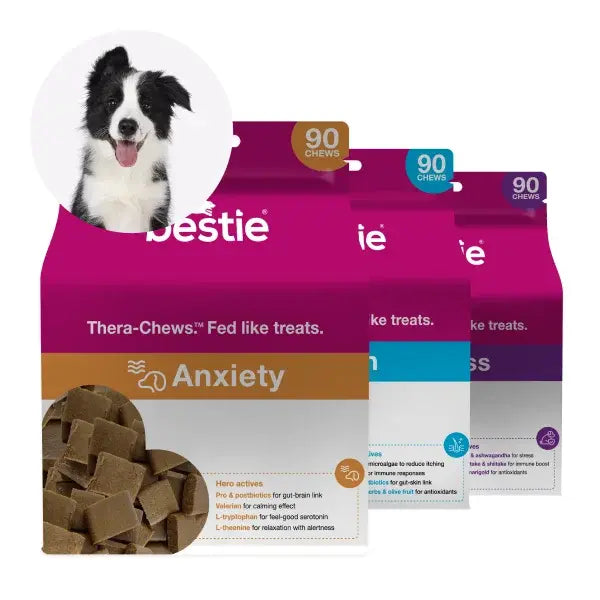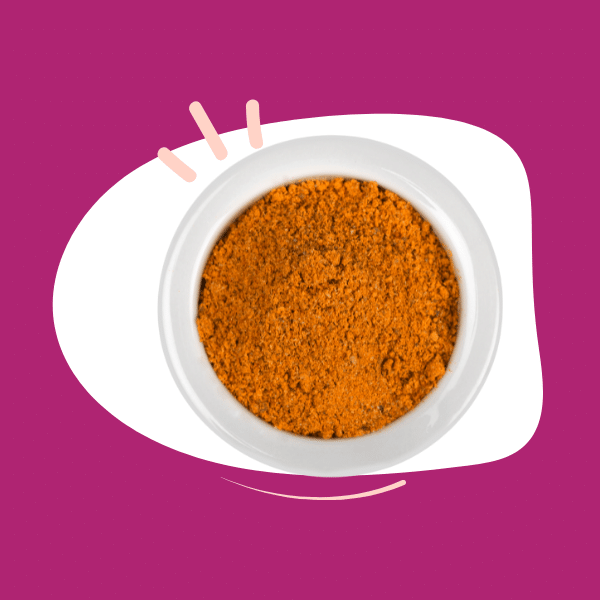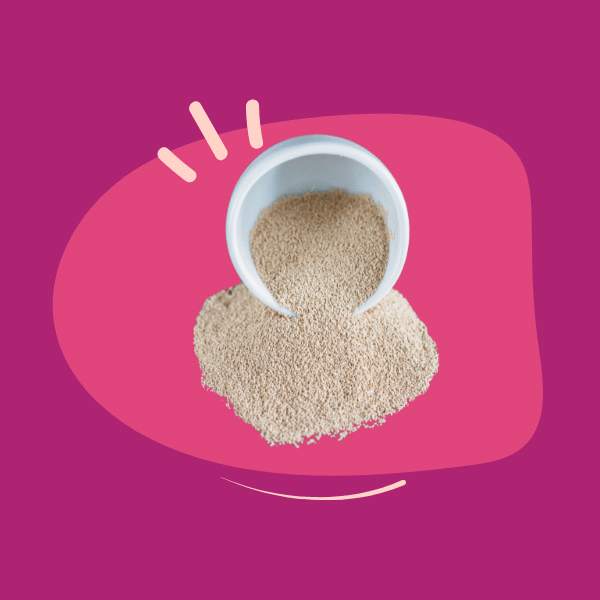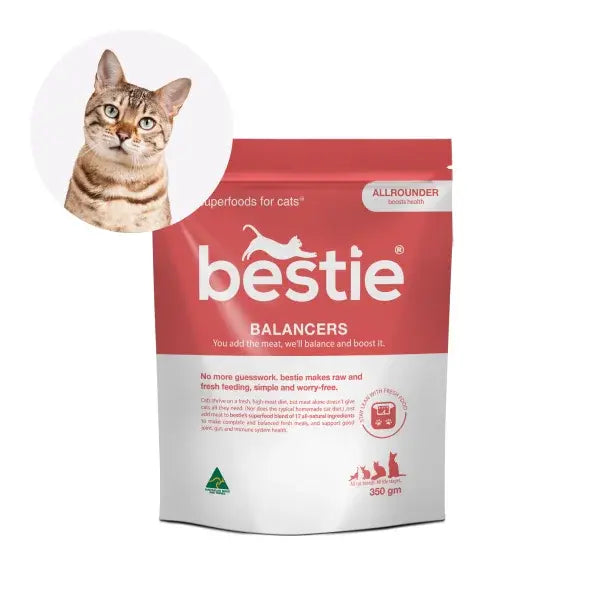It’s part of our daily routine to clean our teeth each morning and evening. But, not all pet parents know that it should be part of a doggy dental care routine too.
‘Recent developments in the field of veterinary dentistry, increased owner awareness, and new treatment techniques make dental care an indispensable part of pet health care. Routine preventative procedures such as brushing the teeth should be a regular aspect of the care we extend to our pets.’ 1 Dr Kenneth F. Lyan, DVM, FAVD, DipAVDC
Luckily, keeping your dog's teeth in tip top condition doesn’t just mean brushing. There’s now a range of doggy dental hygiene products.
In this article we’ll discuss the following ways pet parents can help improve the oral health of their dogs:
- How to brush your dog's teeth – from bought products to the DIY
- Edible options - for our furry friends who need a little more convincing!
- Summary of important doggy dental care points
How to brush your dog's teeth
‘Daily tooth brushing is the most effective single method of reducing plaque accumulation and optimising dog’ oral health’2.
Besides tooth brushes, textile cleaning gloves, microfiber finger cloths have also been shown to reduce plaque build up in dogs.3
The benefits of brushing with cloths are that it can be less intimidating than a brush for your pet. However, cloths will not reach below the gum line in the same way a brush will, and brushing below the gum line is a key factor in preventing the development of periodontitis.
What can you brush with?
Enzymatic toothpaste
This is toothpaste formulated to be both appealing for dogs (in many yummy flavours) and containing antimicrobial enzymes that help decrease bacteria.
Aloe vera
Studies in humans have shown the anti-inflammatory anthraquinones in aloe vera to have beneficial antimicrobial activity when used as tooth gel. Some specific bacteria are even more susceptible to the effect of aloe vera compared to popular commercial human toothpaste.4
Despite a lack of studies in pets, using aloe vera tooth gel could be a solution for dogs with gums particularly sensitive to brushing.
Coconut oil
‘Oil pulling has been proven to be an effective method in reducing plaque formation island plaque induced gingivitis’5 in human studies. The practise of ‘oil pulling’ using coconut oil has been shown to reduce salivary bacterial colony count and plaque index score compared to using chlorhexidine.6
Other studies also conclude that ‘oil pulling using coconut oil could be an effective adjuvant procedure in decreasing plaque formation and plaque induced gingivitis’.7
Oil pulling is a long standing practice that involves swishing oil in your mouth to remove bacteria and promote oral hygiene. Since it can be hard to tell your dog to ‘swish their mouth out’ – good luck with that! – putting it on your finger or gauze as you rub gets the same job done.
While there haven't been a host of studies into the use of coconut oil for oral hygiene in dogs, coconut oil isn't toxic for dogs. Its use with the mechanical abrasion created by the gauze or the brush, plus the fact dogs like the taste means it's often a good go-to DIY option.
How do you do actually do the brushing?
- Firstly, choose a moment when your dog is relaxed.
- Just dab a bit of the coconut oil or aloe vera or toothpaste on your finger with the gauze wrapped over it
- Rub the easiest to reach teeth first...massaging in little circles over the teeth and the gums...Move onto all the teeth you can, as your dog gets more comfortable.
- Aim to do this for 2 - 3 minutes a day if you can.
- Reward your dog so they're happy to do it again!
Edible options
Dental chews
‘Providing a dental hygiene chew daily seems to give an added health benefit when tooth brushing is less frequent’. 8
Dietary supplements
There is another option though, and it’s The Smooch from bestie. It’s a powdered health booster you add to the diet, with cranberry, green tea & citrus polyphenols in vet-formulated clinical daily doses, to help reduce oral bacteria, and freshen the breath. And, it works.
Specialist dental dog food
Food formulated to assist in mechanical cleaning of dog’s teeth usually consists of:
- Fibre to cause more contact with teeth
- Abrasive substances - to mechanically ‘brush’ teeth
- Large pieces
- Substances that prevent mineralisation 9
Studies have proven that ‘daily feeding of dental food significantly reduced plaque and gingivitis by 39% and 36%’10.
However, not all vets agree that this kind of food delivered mechanical cleaning, via dry dog biscuits, works in practice.
“Dry food is mostly bolted whole…no animals press the abrasive compound around the gingival sulcus….Personal experience tells you that chewing a biscuit results in no gum massage. Just the contrary. In fact, the resultant sludge of biscuit paste needs to be brushed away since one’s tongue cannot reach the crevices.” Tom Lonsdale, Pandemic of Periodontal Disease
Bones given as part of a fresh diet can help. However, given that plaque calcifies within 24 – 48 hours, bone chewing at any interval greater than every meal can’t resolve the problem.
Water additives
Water additives such as xylitol have shown a ‘5.1% decrease in mean tooth plaque score and a 14.9% decrease in mean calculus score’ 11 suggesting that their ‘daily administration’ could help to the build up of plaque and calculus on dogs’ teeth.
Water additives may be a good non-invasive addition to mechanical cleaning but are probably not effective enough to be used alone. Xylitol is commonly used in cavity reducing chewing gum but pet parents must be aware that in higher than recommended amounts xylitol can be toxic for dogs.
Important doggy dental care notes:
- If you have your dog from a pup, it’s best to start with teeth cleaning or your chosen doggy dental care routine from day one. Studies have shown a habituation over time to a dental cleaning routine, meaning that the earlier you begin your method of choice, the easier it will become in the future when your dog is older (and stronger!).3
- Although it has been proven that chewing raw bones can act as a good mechanism to clean dogs teeth, it’s worth bearing in mind the risks as well as the benefits. The danger of an unsupervised dog swallowing the bone, fracturing their teeth or damaging the soft structures in their mouth or gastrointestinal system can have life threatening consequences.
- If using a bought option, only use special dog toothpaste (not a human one!). Some of the components of human toothpaste (such as fluoride, sodium lauryl sulphate and xylitol) are harmful to dogs. Dog friendly toothpaste is available at pet stores or you can ask your veterinarian for their recommendation.
- Don’t forget those yearly veterinary dental checks if your dog is over the age of seven. 80% of dogs over the age of 3 years suffer from periodontal disease12 which shows that age is a key factor in the development of dental problems.
- If you notice that your dog has bad breath, loose or missing teeth, difficulty eating or painful gums contact your veterinarian. It is also worth noting that problems in the mouth can lead to problems elsewhere in the body. Weigh your dog regularly so you can notice any changes in their body condition. (We talk about other things to note in this article: Dental Care for Dogs.)_
- Some dogs, such as brachycephalic (short nosed breeds - Pugs, Bulldogs and Shih Tzus) are more prone to dental disease due the organisation of their teeth in a smaller area. If you have one of these breeds, discuss with your veterinarian the best way to clean their teeth.
- When giving your pet any new product for the first time, it’s always important to test it first using a smaller amount of the product than recommended on the label.
Charlotte Francesca Stiles
Charlotte is a 5th-year veterinary medicine student at the University of Zagreb, Faculty of Veterinary Medicine. She is a volunteer at her university's obstetrical clinic, equine clinic, an editor of her university's scientific journal, and dog mum to 12-year-old Chiki.
Charlotte is particularly interested in wildlife medicine and research and hopes that her current extra-curricular work as a student in this area will help her achieve a scientific career after graduation.
References:
- Client Information Handout Reprinted from Pet Focus, with Permission: Dental Home Care, Journal of Veterinary Dentistry Dr. Kenneth F. Lyon, DVM, FAVD, Dip AVDC, First Published June 1, 1991 Research Article, https://doi.org/10.1177/089875649100800206
- Prospective randomised blinded clinical trial assessing effectiveness of three dental plaque control methods in dogs, R. M. Allan,V. J. Adams,N. W. Johnston, First published: 21 December 2018, https://doi.org/10.1111/jsap.12964,
- Improved Oral Health and Adaptation to Treatment in Dogs Using Manual or Ultrasonic Toothbrush or Textile of Nylon or Microfiber for Active Dental Home Care. Olsén, Lena and Brissman, Anna and Wiman, Sara and Eriksson, Fanny and Kaj, Camilla and Brunius Enlund, Karolina (2021)Animals. 11 , 2481
- Comparative evaluation of the antimicrobial efficacy of aloe vera tooth gel and two popular commercial toothpastes: an in vitro study. George D, Bhat SS, Antony B,General Dentistry, 01 May 2009, 57(3):238-241,
- Effect of coconut oil in plaque related gingivitis — A preliminary report, Faizal C. Peedikayil, Prathima Sreenivasan, and Arun NarayananNiger Med J. 2015 Mar-Apr; 56(2): 143–147.doi: 10.4103/0300-1652.153406: 10.4103/0300-1652.153406,
- The effect of oil pulling with coconut oil to improve dental hygiene and oral health: A systematic review, Julian Woolley, Tatjana Gibbons, Kajal Patel, Roberto Sacco, Heliyon,Volume 6, Issue 8, 2020, e04789, ISSN 2405-8440, https://doi.org/10.1016/j.heliyon.2020.e04789. (https://www.sciencedirect.com/science/article/pii/S2405844020316327)
- Effect of coconut oil in plaque related gingivitis - A preliminary report.Peedikayil, F. C., Sreenivasan, P., & Narayanan, A. (2015). Nigerian medical journal : journal of the Nigeria Medical Association, 56(2), 143–147. https://doi.org/10.4103/0300-1652.153406
- The Role of Tooth-brushing and Diet in the Maintenance of Periodontal Health in Dogs, Dr. C. Gorrel, VetMB DDS, Dr. J. M. Rawlings, PhD First Published December 1, 1996 https://doi.org/10.1177/089875649601300405
- https://naturalpetshq.com/dog-food-for-bad-teeth/
- Effects of a Dental Food on Plaque Accumulation and Gingival Health in Dogs, Ellen I. Logan, DVM, PhD, Oliver Finney, PhD, John J. Hefferren, PhD, First Published March 1, 2002 Research Article Find in PubMed, https://doi.org/10.1177/089875640201900102
- Pilot study of the effectiveness of a xylitol-based drinking water additive to reduce plaque and calculus accumulation in dogs Candace Lowe and James Anthony, Canadian Veterinary Journal, Can Vet J. 2020 Jan; 61(1): 63–68.
- Dog Owners' Perspectives on Canine Dental Health—A Questionnaire Study in Sweden, Karolina Brunius Enlund, Carl Brunius, Jeanette Hanson, Ragnvi Hagman, Odd Viking Höglund, Pia Gustås and Ann Pettersson,Front. Vet. Sci., 09 June 2020 | https://doi.org/10.3389/fvets.2020.00298
















